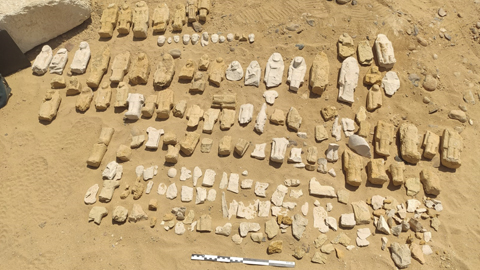This year, the UAB research group in charge of the rescue mission at the necropolis of Kom el-Khamaseen, in southwestern Saqqara, discovered over 100 funerary statuettes of the Egyptian high priest Imephor, each one unique in shape and conception. Researchers also worked on a second site at the royal temple, where they uncovered several fragments of the paintings decorating the building's walls.

This year's campaign is the third by the Spanish-Egyptian Mission in South-West Saqqara, conducted by the UAB and led by Department of Antiquity and Middle Ages lecturer Josep Cervelló, who is also the director of the Institute for Ancient Near Eastern Studies (IEPOA). The dig lasted one and a half months and allowed researchers to complete a systematic excavation of the Kom el-Khamaseen encropolis, which contains the mastaba Imephor Impy Nikauptah, the High Priest of Ptah, the main divinity of Memphis, capital of the country during the Old Kingdom and First Intermediate Period in Egyptian history (2400-2050 BCE).
This year's most important and surprising finding has been a collection of over 100 statuettes of the high priest Imephor, and the priest's full name inscribed in his right arm. These statuettes are completely unique, each with a different shape and conception of the priest, all measuring from 15 to 30 centimetres. The statuettes are similar to the 12 other statuettes archaeologists know to be circulating on the illegal antiquities markets, of which only one has been successfully recovered. Last year researchers recovered two small, highly deteriorated fragments of these types of statuettes, and this gave them the clue about where to find the rest of the collection.
Researchers were also able to recover from Imephor's mastaba 38 blocks or block fragments with inscriptions and reliefs which mainly proceed from the ceiling of the funerary chamber. Made up of two parellel lines of hieroglyphics containing the name and title of the priest, these fragments have allowed researchers to rebuild the chamber's cieling almost in its entirety and fully determine the content of the inscription.
Edifici i pintures de la reialesa
Al nord-est de Kom el-Khamasin, en un segon jaciment de la concessió de la Missió que els investigadors van identificar el 2019 i van anomenar Square Building, els treballs han tret a la llum el que devia haver estat un edifici reial de caràcter cultual, de 37,5 × 33,8 metres, que va ser construït en tovot amb elements de pedra calcària (el llindar i les bases de les columnes), amb un cos central ben definit i tot un seguit de corredors i cambres laterals.
Al cos central de l'edifici els investigadors han fet una descoberta que qualifiquen d'excepcional: un conjunt de pintures en colors vius format per centenars de fragments d'estuc de paret, alguns dels quals de fins a 30 centímetres de llarg, que malgrat el seu estat, molt fragmentari, permeten identificar motius iconogràfics regis, com ara un rei ornat amb un ureu, un Horus de Behdet amb les ales desplegades, un cavall i un carro de combat.
«Atès que són motius clarament associats per temàtica i estil a la reialesa del Regne Nou i que no hem trobat cap evidència que tingués un ús funerari, treballem amb la hipòtesi inicial que l'edifici fos un complex regi per al culte datat d'aquesta etapa de la història egípcia (1550-1070 aC)», explica Josep Cervelló.
Una altra característica essencial d'aquest jaciment són les grans acumulacions de ceràmica (36 en total) que hi ha al voltant, datades també del Regne Nou i amb relació estructural i semàntica amb el complex. Diverses evidències suggereixen que l'edifici del Regne Nou pot haver-se aixecat damunt un jaciment anterior, del Regne Antic. «Futures investigacions ens hauran de permetre aclarir-ho, cosa que seria particularment interessant en relació amb un dels objectius científics del nostre projecte: l'estudi dels patrons d'ocupació cultural del territori durant el Regne Antic i el Primer Període Intermedi», precisa Cervelló.
D'esquerra a dreta i de dalt a baix, cares seccionades d'estatuetes de Imephor Impy Nikauptah trobades soltes, part de l'equip investigadors celebrant l'aparició de les primeres tres estatuetes, fragment de pintura amb el cap d'un rei tocat amb l'ureu, l'equip de la UAB i el Supreme Council of Antiquities egipci de la campanya 2022 i excavació de l'Square Building.
Altres treballs desenvolupats enguany han permès documentar la indústria lítica de la superfície de l'extensa zona desèrtica de la concessió, que ha estat datada preliminarment del Paleolític mitjà (Middle Stone Age). «Aquests treballs ens permetran reflexionar sobre el paper que va poder tenir el nord d'Egipte en les rutes de sortida de l'Homo sapiens de l'Àfrica», apunta l'investigador de la UAB.
El projecte de Kom el-Khamasin, de la Missió Hispano-Egípcia a Saqqara Sud-oest, està organitzat per l'IEPOA-UAB i el Consell Suprem d'Antiguitats d'Egipte, i compta amb el suport del Ministeri de Ciència i Innovació, del Ministeri de Cultura i Esport, de l'Institut Català d'Arqueologia Clàssica, de la Fundació Palarq i de l'empresa Image Tours.
La intervenció de rescat a Saqqara de l'equip de recerca de la UAB compta també amb el suport de nombroses persones, que hi han participat a través d'una campanya de microdonacions en el marc del programa de mecenatge de projectes de recerca de la Universitat.






